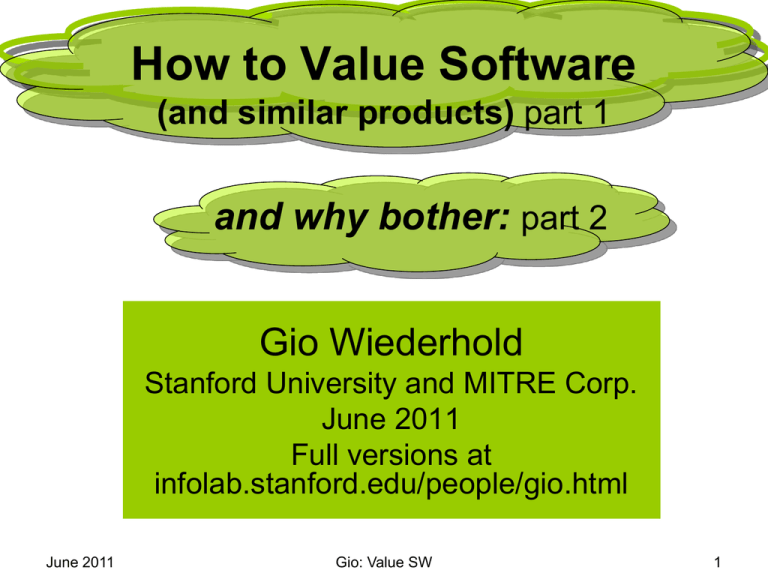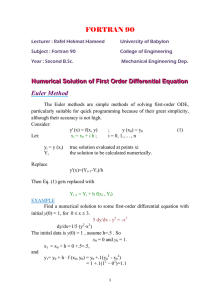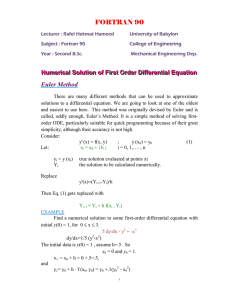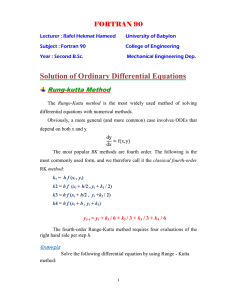How to Value Software Gio Wiederhold and why bother: (and similar products)
advertisement

How to Value Software (and similar products) part 1 and why bother: part 2 Gio Wiederhold Stanford University and MITRE Corp. June 2011 Full versions at infolab.stanford.edu/people/gio.html June 2011 Gio: Value SW 1 Current State • Software producers traditionally care about – Cost of writing software – Time to complete products – Capabilities • When the value is a concern – Investors – Economists – Lawyers – Promoters – Tax advisors June 2011 life inconsistent Gio: Value SW 2 Why should one care? • Investors: assess what they will own. • Investors: know what the result is really worth. • Designers: make the tight decisions – if the products is likely valuable, invest more – if is likely to be worth little, not spend too much • Computer scientists: know what’s going on • Tax authorities: Value exports Other professions have reasonable insights Architects, hardware manufacturers, . . . June 2011 Gio: Value SW 3 What is the problem? Create some software and ship it on a CD to a company that sells software. • Let’s assume they get the exclusive right to the SW. What should the company pay you? 1. The cost of the CD and mailing it? about $10.-? 2. The cost to write the SW placed on the CD: 5 months at $10,000/month = $50,000.- ? 3. Half of their sales that year (~ 50% is cost of selling) : 50% of 10,000 copies at $49.99 = $250,000.- ? 4. 50% of their $2M lifetime sales = $1,000,000.- ? • Does the creator or seller still have obligations? June 2011 Gio: Value SW 4 Why is value a Concern • Making decisions about creative tradeoffs – Elegance versus functionality – Rapid generation versus maintainability – Careful specification versus flexibility • Model of Dealing with customers Dijkstra model: for self-satisfaction Engineering model: satisfy formal external specifications Startup model: see if it sticks to the wall June 2011 Gio: Value SW 5 Why now Worrying about economics is a sign of a maturing field Phases: 1.Get new stuff to work 2.Getting adequate performance 3.Get it to be sufficiently reliable to be useful 4.Get it into routine production 5.Increase capacity 6.Make it safe 7.Make it affordable June 2011 Gio: Value SW 6 Why me • • • Much software is being exported as part of offshoring (offshore outsourcing) It is typically property – i.e., protected If it is misvalued 1. 2. 3. 4. 5. June 2011 Loss of income to the creators And loss of taxes to governments Excessive profits kept in tax havens Increased motivation for offshoring Reduced investment for future jobs Gio: Value SW 7 Intangibles • • Product of knowledge Cost of original >> cost of copies 1. 2. 3. 4. 5. 6. June 2011 Books Software Inventions Trademarks Knowhow Customer Loyalty Gio: Value SW by authors programmers engineers advertisers managers long-term quality 8 Valuation of intangibles • Principle The sum of all future income discounted to today (NPV) Implicitly estimated by share holders • Example: Value of a company (SAP) – Largely intangible – like many modern enterprises 1. Market value = share price × no. of shares €31.5B 2. Bookvalue – sum of all tangible assets € 6.3B 100% 20% Equipment, buildings, cash 3. Intangible value per stock market €25.2B 80% Intangible/tangible = 4 x – June 2011 How much of it is software ? Gio: Value SW 9 • Sum of future income • Sales = price * copy count • Maintenance fees if service subscription • Minus sum of future costs • • • • Cost of goods Cost of marketing Cost of doing business Cost of maintenance • Discounted to today • To account for risk June 2011 Gio: Value SW Independent of cost Basis for SW value as of today 10 Software has a dynamic life ! Continuously updated 1. Corrective maintenance bugfixing reduces for good SW 2. Adaptive maintenance Life time 100% 80% 60% externally mandated 3. Perfective maintenance satisfy customers' growing expectations 20% Ratios differ in various settings [IEEE definitions] June 2011 40% Gio: Value SW 11 IP sources • Corrective maintenance – Feedback through error reporting mechanisms • Inadequate protection from virus etc. • Taking care of missed cases • Complete inadequate tables and dimensions • Adaptive maintenance – Staff to monitor externally imposed changes • Compliance with new standards • Technological advances • Perfective maintenance – Feedback through sales & marketing staff • Minor features that cannot be charged for June 2011 Gio: Value SW 12 Effect: SW Size Growth Rules: Sn+1 = 2 to 1.5 × Sn per year [HennesseyP:90] Vn+1 ≤ 1.30% × Vn [Bernstein:03] Vn+1 = Vn + V1 [Roux:97] [earlier indications] Deletion of prior code = 5% per year [W:04] at 1.5 year / version June 2011 Gio: Value SW 13 Price remember IP =f(income) • Price stays ≈ fixed over time like hardware Moore's Law Because 1. 2. 3. 4. • Customers expect to pay same for same functionality Keep new competitors out Enterprise contracts are set at 15% of base price Shrink-wrapped versions can be skipped Effect The income per unit of code reduces by 1/size June 2011 Gio: Value SW 14 Growth diminishes initial IP For constant unit price at 1.5 year / version June 2011 Gio: Value SW 15 Total income Total income = price × volume (year of life) • Hence must estimate volume, lifetime Best predictors are Previous comparables Erlang curve fitting (m=6 to 20, 12 is typical) and apply common sense limit = Penetration estimate total possible sales F × #customers above F= 50% monopolistic aberration P June 2011 Gio: Value SW 16 Sales models 1. Normal curve: simple, no defined start point 2. Erlang: realistic, more complex both have same parameters: mean and variance June 2011 Gio: Value SW 17 Lag delays benefits of R&D investments Effective lag Effort → ~37% → @27.4% → ~14% → Testing Development Research 35%→ start June 2011 75% 50% Gestation period → Gio: Value SW 25% done 18 Software users & IP Companies that 1. develop & sell software • → * Basis of IP: income from sales 2. purchase & license software for internal use • Do not generate IP with software 3. develop software internally for their own use • Basis of IP: relative SW expense × all income (Pareto rule) 4. combinations June 2011 Gio: Value SW 19 Fraction of income for SW* Income in a software company is used for • Cost of capital typical – Dividends and interest ≈ 5% • Routine operations -- not requiring IP – Cost of manufacturing goods sold (COGS) ≈ 5% – Distribution, administration, management ≈ 40% • IP Generating Expenses (IGE): – Research and development, i.e., SW – Advertising and marketing ≈ 25% ≈ 25% These numbers are available in annual reports or 10Ks June 2011 Gio: Value SW 20 Discounting to NPV Standard business procedure • Net present Value (NPV) of getting funds 1 year later = F×(1 – discount %) Standard values are available for many businesses based on risk (β) of business, typical 15% Discounting strongly reduces effect of the far future NPV of $1.- in 9 years at 15% is $0.28 Also means that bad long-term assumptions have less effect June 2011 Gio: Value SW 21 Example Software product Sells for $500/copy Market size 200 000 Market penetration 25% Expected sales 50 000 copies Expected income $25M June 2011 Gio: Value SW 22 Combining it all factor Version today y1 1.0 y2 2.0 y3 y4 3.0 500 y5 4.0 unit price $500 500 500 500 Rel.size 1.00 1.67 2.33 3.00 3.67 New grth 0.00 0.67 1.33 2.00 replaced 0.00 0.05 0.08 old left 1.00 0.95 Fraction 100% 57% y6 y7 5.0 500 y8 y9 6.0 7.0 500 500 500 500 4.33 5.00 5.67 6.33 7.00 2.67 3.33 4.00 4.67 5.33 6.00 0.12 0.15 0.18 0.22 0.25 0.28 0.32 0.92 0.88 0.85 0.82 0.78 0.75 0.72 0.68 39% 29% 23% 19% 16% 13% 11% 10% Annual $K 0 1911 7569 11306 11395 8644 2646 1370 1241 503 Rev, $K 0 956 3785 5652 5698 4322 2646 1370 621 252 SWIP 25% 0 239 946 1413 1424 1081 661 343 155 63 Due old 0 136 371 416 320 204 104 45 18 6 Disct 15% 1.00 Contribute 0 Total June 2011 0.87 118 0.76 281 0.66 274 0.57 189 0.50 101 0.43 45 0.38 17 0.33 6 0.28 2 1 032 ≈ $ 1 million Gio: Value SW 23 Result of Example • Selling 50 000 SW units at $500 ≈ $ 1M not $ 25M Once its in a spreadsheet, the effect of the many assumptions made can be checked. When assumptions later prove unwarranted then management can make corrections. To be wise, don't spend more than ≈ $500 000 to develop the software product. June 2011 Gio: Value SW 24 Alternate business model Consider maintenance and its income "Service model" • More assumptions – now include cost 1. Original cost $516 000 (used to estimate 2.) 2. Maintenance cost 15%/year of original cost 3. Maintenance fee 15%/year of original price 4. Lag = Δ (t cost , t income) = 2 years 5. Stop maintenance when cost > income June 2011 Gio: Value SW 25 Effect of service model factor today Version 1.0 Org.cost $K 516 Maint.cost y1 y2 y3 2.0 y4 3.0 y5 4.0 y6 y7 5.0 y8 6.0 y9 7.0 0 77 129 181 232 284 339 387 0 77 207 387 619 903 1239 1626 Disc.(lag) 0 102 171 239 307 376 444 512 0 0 income 0 240 946 1413 1424 1081 661 343 103 21 Net income 0 137 776 1174 1117 705 218 -170 103 211 Contribute 0 119 586 772 639 -64 32 6 Aggregate Total 351 2 537 ≈ $ 2.5 million Assume designed for maintenance 94 0 not discounted but $ 1626 for maintenance Good time to quit Cost of maintenance = 1626/(516+1626) = 61% of total June 2011 0 Gio: Value SW Reduce income 1/3 each year typical 26 Service model « Analysis shows profitability in service model • To achieve such a beneficial model 1. Management must value maintenance 2. Marketing and sales must provide feedback 3. Education and training must recognize the value of maintenance and maintainability – Often ignored today 1. Academics don't teach it (3/850 pages [Pressman:01]) 2. Companies give maintenance tasks to novices Experienced programmers should maintain their work June 2011 Gio: Value SW 27 Knowing what software is worth • Allows rational design decisions, as • Limiting development efforts • Programming investment for maintenance • Understand limit to Software Life When cost of maintenance > income • Allows rational business decisions, as • • • • Choice of business model Where and when to invest How to assign programming talent Adjustment when assumptions turn out to be wrong • Improve focus of education in software • Consider quality, not just quantity in assignments • Effectiveness of curriculum June 2011 Gio: Value SW 28 ( SW is only a part of intellectual capital Labor + Property includes knowledge used in a business I P Typical ranges for a creative company • Total value of a company (~ market value) 1. 2. 3. 100% Tangible property (in knowledge-based enterprises) < 20% Workforce–in-place (not property nowadays) ~30% Intellectual property (IP) (unique to the company) ~50% • • • • Patents Software under NDA Copyrights held Trademarks 5% to 20% of the IP 10% to 70% of the IP 0% to 5% of the IP 20% to 50% of the IP IP is the essential component for a modern company to generate income and to grow. June 2011 Gio: Value SW Wor k forc e Tang ible 29 What happens next? Outsourcing & Offshoring 1. Moving jobs to jurisdictions that can be exploited for tax avoidance 2. Moving IP to taxhavens 3. Moving revenue to jurisdictions without visibility A company can live in many places June 2011 Gio: Value SW 30 Earnings Flow Taxes Profits Public & Private Investments Commodity Products Common Knowledge InteKnow-How gration HighIntel- of. workforce Tradevalue lectual . marks ...products Intellectual Capital . Property (IP) Technology Taxes Profits non-routine Segregation of IP rights from locale • Tangible value based on cost + margin ≈ price Creator € $ • Intangible value based on income potential, ≈ cost Creator User Owner € $ June 2011 User Owner Gio: Value SW 32 Taxhavens CFH: Prime taxhaven no personnel, holds only $ and IP CFC: Semi taxhaven operations, personnel, needs IP CFI: Financial intermediary no personnel, no long-term $ Are used together to reduce owner’s taxes June 2011 Gio: Value SW 33 Primary Taxhaven CFH Jurisdiction – country/kanton -- where • Taxes are low or non-existent fee income only is adequate: Cayman Islands: 90,000 co’s x $3000 for 55,000 locals. • Holding companies are easy to set up delegated to legal firms • Corporations are minimally controlled few rules, no public records • No local workforce needed June 2011 Gio: Value SW 34 Semi Taxhavens CFC Jurisdiction where • Competent local workforce easy immigration for educated • Taxes are territorial Profits from external revenue not taxed • Incentives are provided for investors Real estate, employee training, R&D support, tax forgiveness for some time, • Supervision of corporations is modest June 2011 Gio: Value SW 35 Secondary Taxhavens IFC Jurisdiction where • Financial interchange is convenient Banking services under contract • Taxes are strictly territorial Profits from external revenue not taxed • Little supervision of non-local business Exclusion rules if just an intermediary • No local workforce expected June 2011 Gio: Value SW 36 Double Irish / Dutch Sandwich Typical arrangement comprises 3 types CFH US Parent Company CFH IFC Operational CFC In practice dozens of entities in many different countries June 2011 Gio: Value SW 37 Interaction among Foreign Entities 1. Controlled Foreign Operations CFC Operations licensing the IP, routine profit 2. Taxhaven companies to hold the IP The IP held there earns most profits CFH 3. Shell companies to allocate of income Keep income invisible • Avoids taxation of sales IFC June 2011 Gio: Value SW 38 Effect for US, 2005-2010 June 2011 Gio: Value SW 39 Detail for IP Shifting: Why? Jobs & IP goes together [Marx], also when Offshoring IP represents the capital of modern manufacturing • In order for offshore workers to be productive, the IP they need is offshored as well. • But rights to IP are segregated – A holding company (CFH) is established to holds the IP. – Offshore profits, income above what is needed to operate & pay offshore workers, is credited to the CFH. The transfer of income is by paying royalties to the CFH. June 2011 Gio: Value SW 40 Summary IP is poorly understood, but crucial to generating high profits in high-technology IP can be valued, but is often misvalued IP is not seen on books, provides opportunities for funny arrangements IP rights can be segregated to move profits for tax avoidance Traditional models used by governments fail June 2011 Gio: Value SW 41 Questions? Arguments? June 2011 Gio: Value SW 42 Radical Prescription Do away with Corporate income tax entirely • Compensate by increased taxes on dividends – Would encourage investment over paying dividends • Stop treating a corporation legally as a person – Now lobbyists can promote nice rules for individuals, that become tax loopholes for corporations Will now justify corporate objective that the duty of a corporation is to maximize benefits for stockholders The objectives and morals do differ! 22-Jun-11 June 2011 Loss Gio: due toValue IP Export SWV4 43 43 June 2011 Gio: Value SW 44 Intellectual Resources Private & Public Intellectual Capital Rights owned by the business Intellectual Assets Available for transfer Intellectual Property Legally protectable Patents Copyrights Trade secrets Trade marks Contracts covering intellectual capital Tangible Property Simile 1. 2. Company USco has built and owns building B Sells B to a financial company in Bermuda REc, but actually B REc(B) USco has set up that REc as a holding & provides a mortgage 3. Now USco pays REco lease rates for use of B 4. REco pays mortgage & maintenance to keep up B’s value 5. REco profits, pays few taxes, profit is consolidated with USco Intangible property simplifies hiding of funny deals June 2011 Gio: Value SW 46 Sales curves used % Depreciation Normal Erlang 100 90 80 70 Vn 60 Vn+1 Vn+2 50 40 30 20 10 0 0 June 2011 1 2 3 Gio: Value SW 4 5 years 47 Asset Life under maintenance years 12 Life span 9 90 8 80 7 70 6 60 5 50 40 4 3 30 2 20 1 10 PCs cars software Typical Life 3years 5 years 12 years Maintenance 2%/year 5%/year 15%/year Maintenance costs 6% 21% 80% Depreciation 33/y. linear 20%/ y. linear 8%/y. linear intangibles depreciation / year 100% 10 Life span maintenance /ownerhip cost ratio indefinite 11 0 18 years expected . 13.75%/year compounded . most over asset life 12% geometric of investment Income Development lag Centroid of total development costs . Research, Design, Simulation ← Centroid of revenue Integrate &Test Sales lag ~60% → Marketing lag Costs Costs → $ Marketing Part of CoGSales Centroid of pre-sales . marketing costs time → Income from sales → Manufacturing & distribution delay Lag for 3 company situations Growth limit Av. Effort 30 % Lag centroid @ 0.27 of period Testing R&D start done Av. Effort 50 % Testing Lag centroid @ 0.33 of period R&D done start Av. Effort 70% Lag centroid @ 0.42 of period before done lim Testing Growth limit start R&D done Accumulating profit in a CFH • The fraction of profits that can be legitimately transferred to the CFH is the fraction of `Non-routine profits’ equal to the CFH ownership. Routine profits are those made by a company without IP, typically 5%-10%, but high-tech net profit %s are ~50% • The IP fraction transferred offshore may just be proportional to the foreign income: Justifiable • There is no fundamental reason why not all IP cannot be legitimately moved to a tax haven ? June 2011 Gio: Value SW 51 Details 2 “Non Routine-profits” There is a variety of economists’ approved methods to determine what fraction of profits is due to SW IP. In general: 1. 2. 3. 4. 5. Start with revenue from sales, say 500,000 copies at $200 Subtract cost-of-goods-sold – minimal for SW Subtract other identifiable costs - licenses etc., (none?) Subtract distribution cost if known, or typical % (5-15%) Subtract profit margin for similar goods without IP, say selling open-source software ~5-10% 6. The remainder is due to SW IP and Marketing IP 7. If marketing IP is not in tax haven, split it off (often 50%) 500,000 x $81 = $40.5M of $100M for SW goes to tax haven. June 2011 Gio: Value SW 52 Capital flow with a taxhaven Controlled Foreign Holding Company Source IP Creator Income Capital CFH I PIP IP license Buy-in Tax havens: Vanuatu Cayman islands Barbados Isle of Man US Fees taxes Tangibles are harder to move than IP June 2011 CFC IP consumer Gio: Value SW Income Royalties Capital Foreign taxes 53 Details 3: Tax avoidance 1. Paying royalties for use of IP is a legitimate expense and deducted from taxable income. 2. There is little or no control on setting of royalties Setting a correct royalty also requires an IP valuation Easily set excessively high 3. Royalties are also collected from offshore sites, especially if that reduces taxes too. • Tax rates in India are similar to the US, Irish rate is still money • Non-US tax authorities understand IP very poorly The benefits of globalization are only the jobs, all countries lose out on corporate taxes June 2011 Gio: Value SW 54 Details 4: $ & IP held by CFH grow • Once the value of the IP transferred Export is paid off, no income from the CFH goes to the Parent company – Regulations allow payment for IP over multiple years, so that no spikes occur, and tax loss is gradual. – In formal reports the CFH’s are integrated with the parent company, so that employees nor stockholders know about offshore flows. • The CFH pays cost of all R&D performed in the Parent and offshore, to assure that the CFH owns the IP. Parent and offshore employees are unaware of the source of their paycheck 22-Jun-11 June 2011 Loss due to IP Export V4 55 Gio: Value SW 55 Details 5: Setting up Tax Havens • Few companies have the smarts themselves • A few consulting firms are very active, get high fees – Convince USco tax VPs that they can reduce taxes – Formulate and present plans to board of directors • • • • Members of the board are impressed by saving Most board members in high-tech companies are technical Discussion and understanding is avoided or minimized Risks are glossed over: `It is more likely than not that the IRS will not challenge this transfer … ‘ • Moral issues are completely ignored – not a concern for USco • Consulting firms operate the mailbox CFH services • Small companies are at a cost disadvantage June 2011 Gio: Value SW 56 Long term Summary IP creates profit where it is located, not where it is used • • • • • IP and profits are put into a tax haven by setting up a CFH Semi-taxhavens gain jobs, but negligible corporate tax due to sandwich Repatriation of $$ from the CFH to the US is avoided. Tax avoidance means infrastructure –schools, services, etc suffer IP generating workers (R&D, creative folk) are paid by the CFH. US and offshore employees are unaware of the source of their paycheck – The CFH acquires an increasing fraction of the IP – The CFH is paid an increasing fraction of the income – The CFH in time can becomes richer than the company. • It seems best for the company to invest in low-tax countries and create jobs there. – Job losses in the U.S. increase • Eventually the CFH can buy the parent company: Inversion. – Control by stockholders is gone as well • Few people know what is going on, and those that do, don’t talk. June 2011 Gio: Value SW 57 Example from Business Week 1/4 21 Oct 2010 nearly irrelevant June 2011 Gio: Value SW 58 Example from Business Week 2/4 plus the Dutch sandwich Ireland has territorial taxation The US & UK tax All three are sub-divisions of the same CF corporation June 2011 owns IP worldwide Gio: Value SW 59 Example from Business Week 3/4 June 2011 Gio: Value SW 60 Example from Business Week 4/4 Google only shifted European income for collection in the Netherlands and allocation to taxhavens. Other companies have shifted also IP pertaining to US income to taxhavens June 2011 Gio: Value SW 61 Global philosophical questions Happiness or contentment • Personal More cheap stuff --- a benefit of offshoring Less employment --- a cost of offshoring • Global benefits of offshoring -- long term Greater income equality among countries Similar working conditions within countries NAFTA or EU - neighboring countries Friendly countries World-wide Taxhavens • Can a corporation or government be happy? • Should Corporations be treated as Persons? June 2011 Gio: Value SW 62


